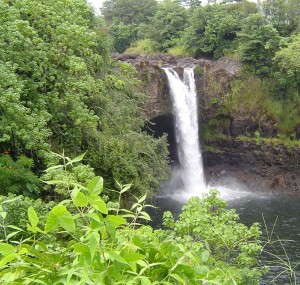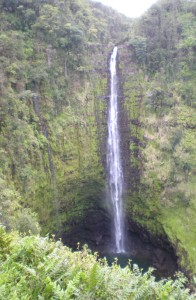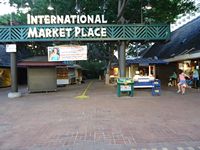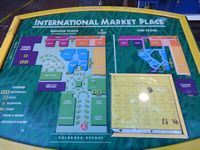Hilo…lots of rain also means waterfalls
As promised in an earlier post, this post will discuss the Big Island town of Hilo, which retains the look and feel of downtown from 100 years ago, including many of the original buildings.
Hilo is known for being rainy all the time…it does get over 70″ of rain annually, which makes it the wettest city in the US. What all this rain also brings is the lushness and greenery that people come to expect of a tropical paradise and in stark contrast to the much drier Kona side of the island, which is where all the resorts are.
Another benefit from all that rain are the waterfalls located on this side of the island. Rainbow Falls is located about 5 minutes outside of downtown Hilo, along the Wailuku River. Its easy to get to and the viewing area is a short 100 yards from the parking lot.

Rainbow Falls, 5 minutes away from downtown Hilo
If you head back to town and get on Bayfront Highway (aka Hwy 19), head north, and in about 10 miles, you will come to the turn off to 420′ Akaka Falls.

420′ Akaka Falls, Big Island
Back in Hilo, you may want to stop at Waialoa River State Park and see the 3rd statue of King Kamehameha the Great. This statue was originally commissioned by the Princeville Corporation for placement at the Princeville Resort on Kauai. Due to Kauai resident resistance, they ultimately gifted the statue to Hilo, which was his political center.
It seems that the residents of Kauai were upset because Kauai was the only island that was not conquered by King Kamehameha. The king of Kauai, King Kaumualii, wanting to avoid all that comes from fighting what he could see would be a losing cause, came to terms with King Kamehameha and avoided all the unnecessary bloodshed.
(The most renown statue of King Kamehameha stands in Honolulu, across from Iolani Palace and the remaining statue stands in the town of Kapaa in the Kohala District of the Big Island.)
Any visitor to Hilo cannot help but notice the large park area located just south of the downtown area, fronting Hilo Bay. At first, this seems like a waste of valuable land. What visitors must understand is the reason this green area exists is because on April Fool’s day, 1946, a large tsunami hit Hilo and killed 146 people and destroyed 1300 homes!
And, if that wasn’t bad enough, 14 years later on May 19, 1960, another tsunami struck Hilo at 1:04 a.m. killing an additional 61 people. It was agreed that they would not rebuild in that area and the green area was turned into a park dedicated to those who lost their lives. There is an old style, city square type clock which stands in the park, forever stuck at 1:04 in memorial to them.
Cafe 100, located on Kilauea Ave, is considered to be the home of the popular “loco-moco”. The original dish consisted of a bowl of rice, topped with a hamburger patty, a fried egg, and a generous heaping of brown gravy…a nutritionist’s nightmare meal. The current menu offers a lot of variations, replacing the hamburger patty with Portuguese sausage, Spam, etc.
Speaking of food, stop at the Big Island Candies factory. Along with a line of mouth-watering chocolate-dipped scotch-bread cookies and brownies, they also offer some uniquely Hawaiian snacks, found nowhere else. Care to try some chocolate-covered ika (dried squid)? (I have to admit, the chocolate-covered ika was not one of my personal favorites.)
Retailer Hilo Hattie had its humble beginnings here in Hilo. Today, they have outlets in Honolulu, Maui, Kauai, and Kailua-Kona, but there flagship store in Hilo has closed. It may come as a surprise to you, but they also have stores in Orange County, California; Tempe, Arizona; Miami, Florida; Las Vegas, Nevada and Orlando, Florida! The store got its name from an entertainer who went by that moniker and who sold the marketing rights to this fledgling attire manufacturer before passing away. Other than that, she never had any financial ties to the store itself.
The Merrie Monarch Festival
Hilo is host to the annual Merrie Monarch (Hula) Festival, held in late April. This competition sells out quickly every year, so if you’re planning a trip to the Big Island around that time of the year, make your reservations early. And, even if you don’t plan on attending, but will be on the Big Island at that time, you should know that rooms and car rentals are hard to come by. Tickets go on sale the day after Christmas.
Add the fact that the Hawaii Volcanoes National Park lies just 30 minutes away versus the almost 2-hour drive from Kailua-Kona, and you can start to appreciate that maybe Hilo deserves consideration as a destination point, rather than just another pit-stop on your around-the-island run.






